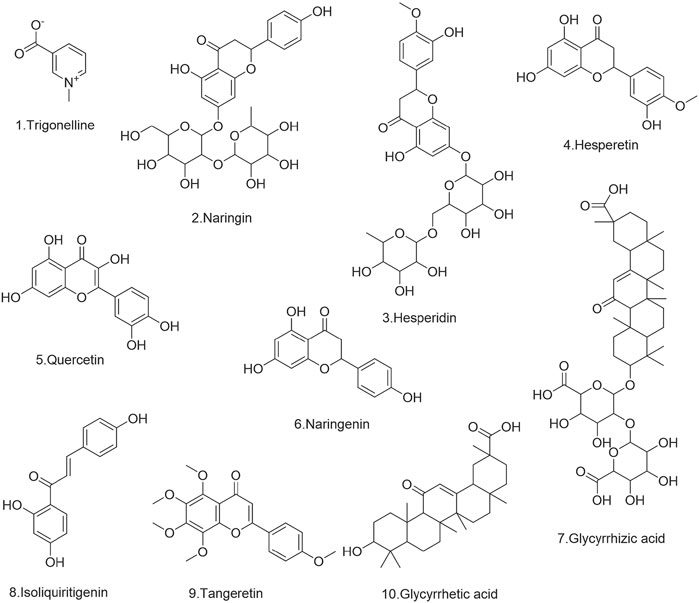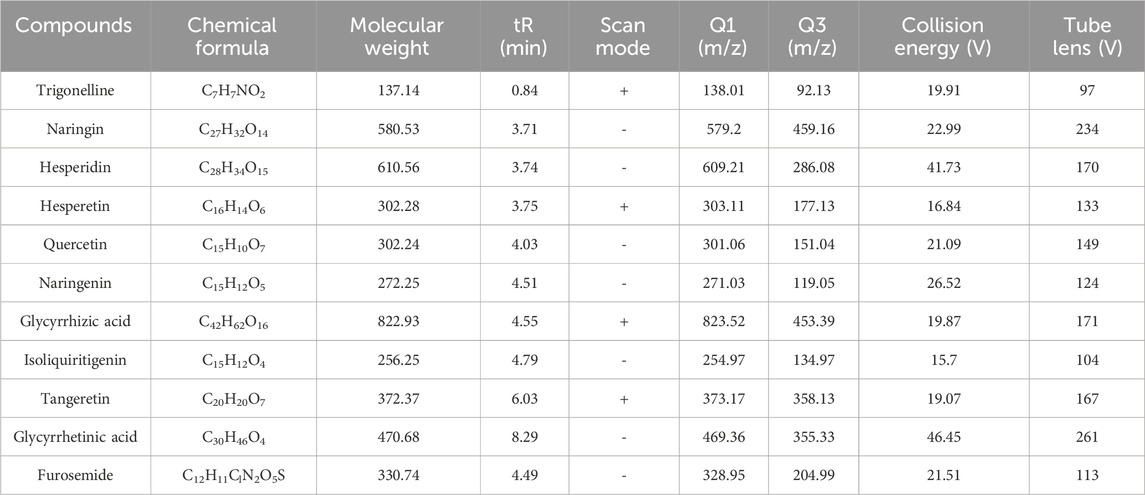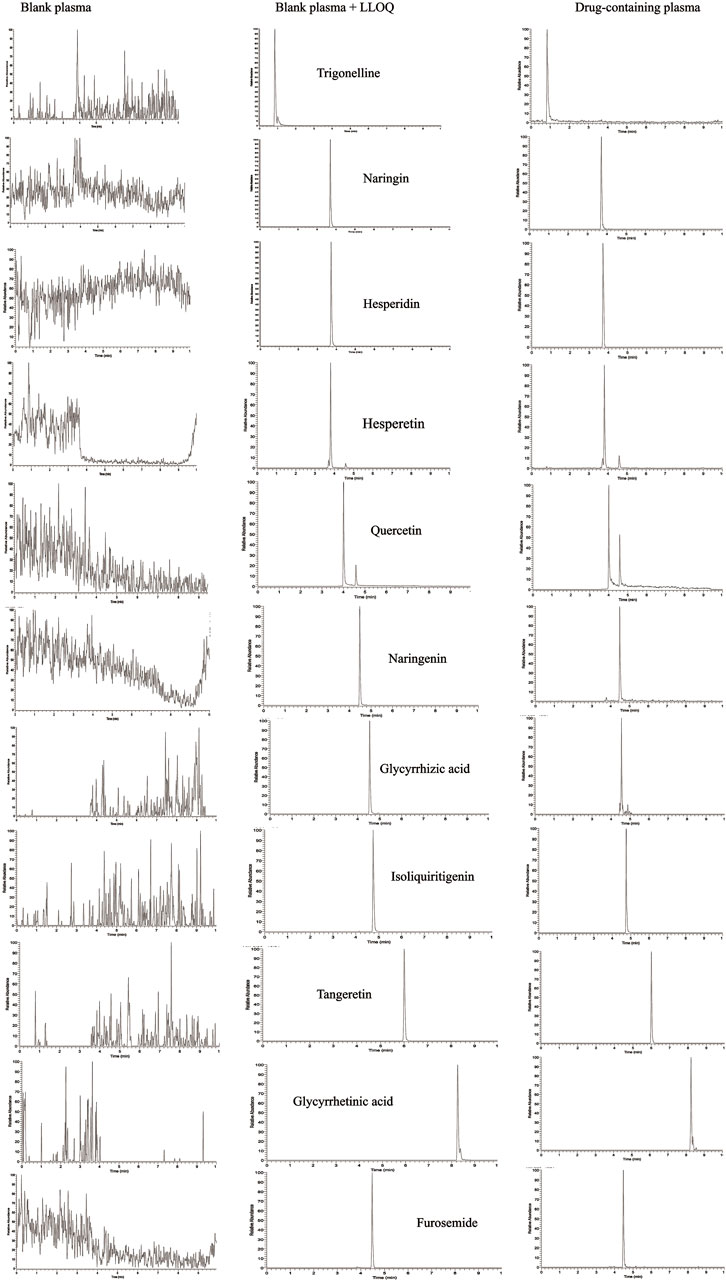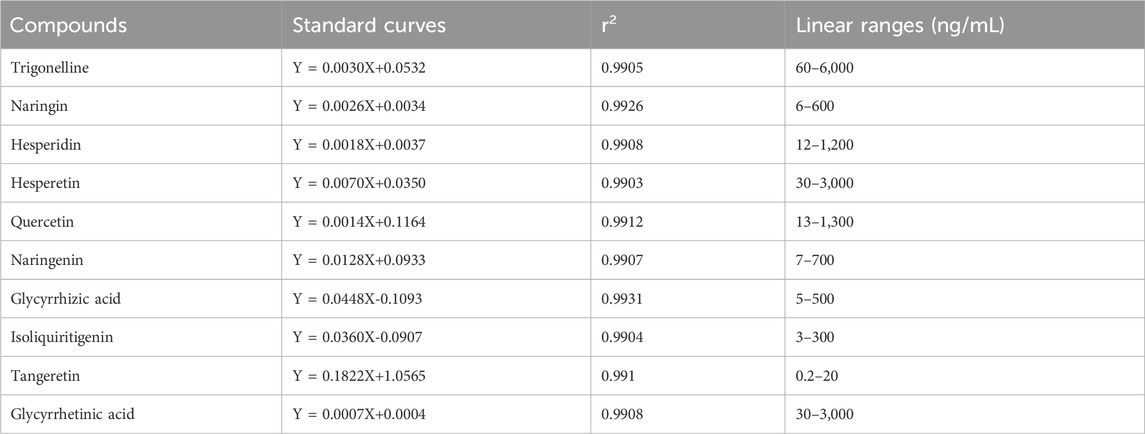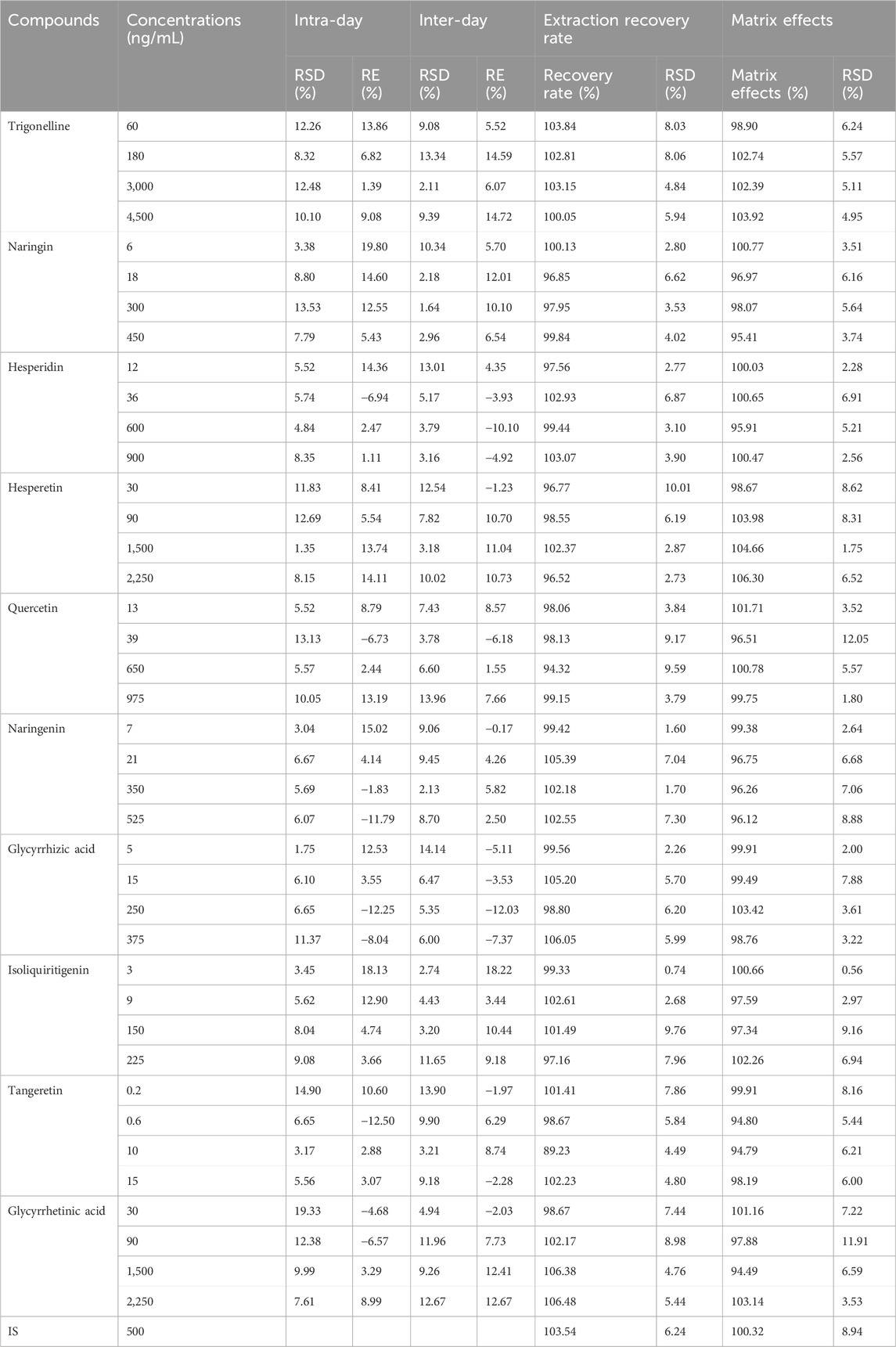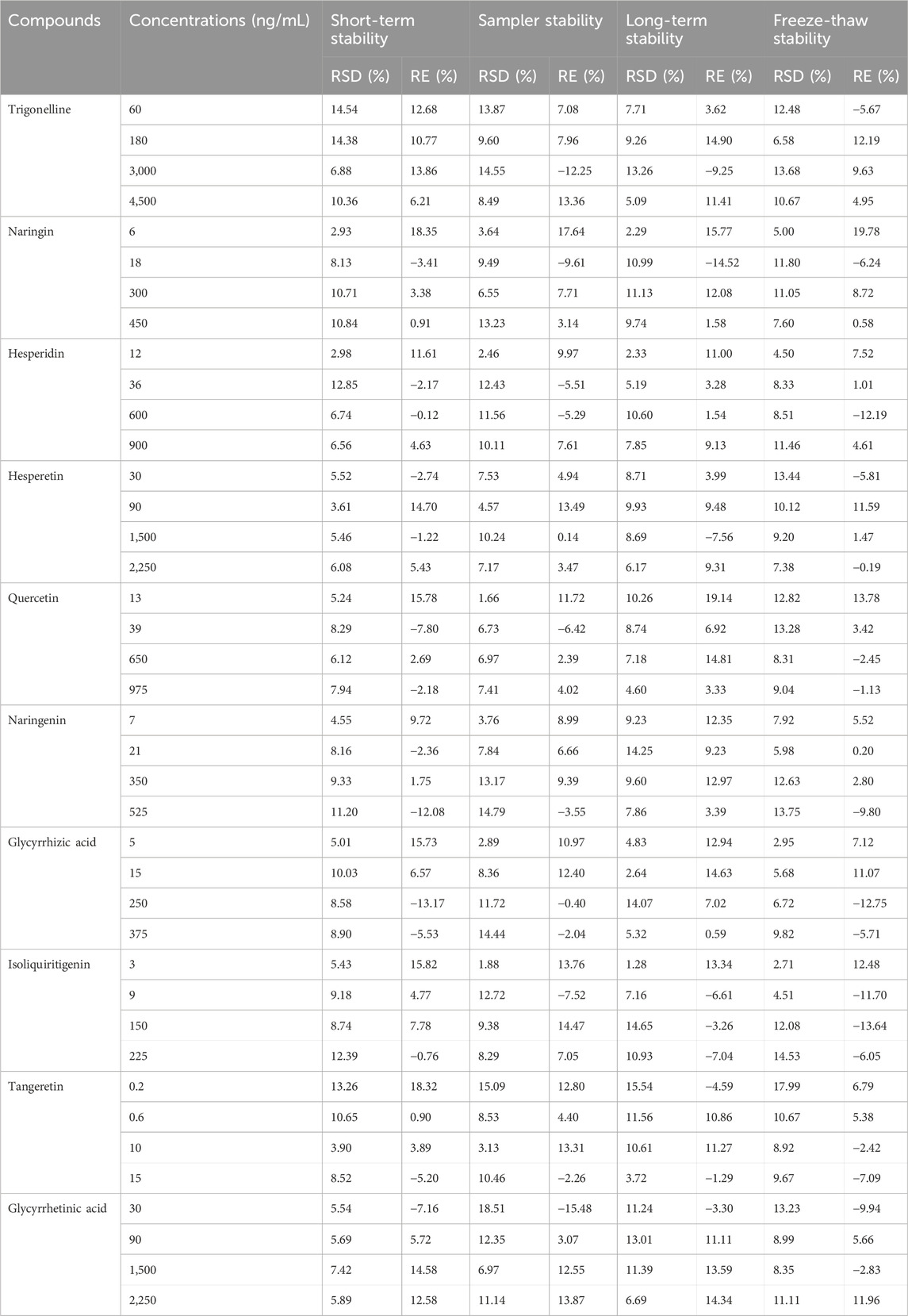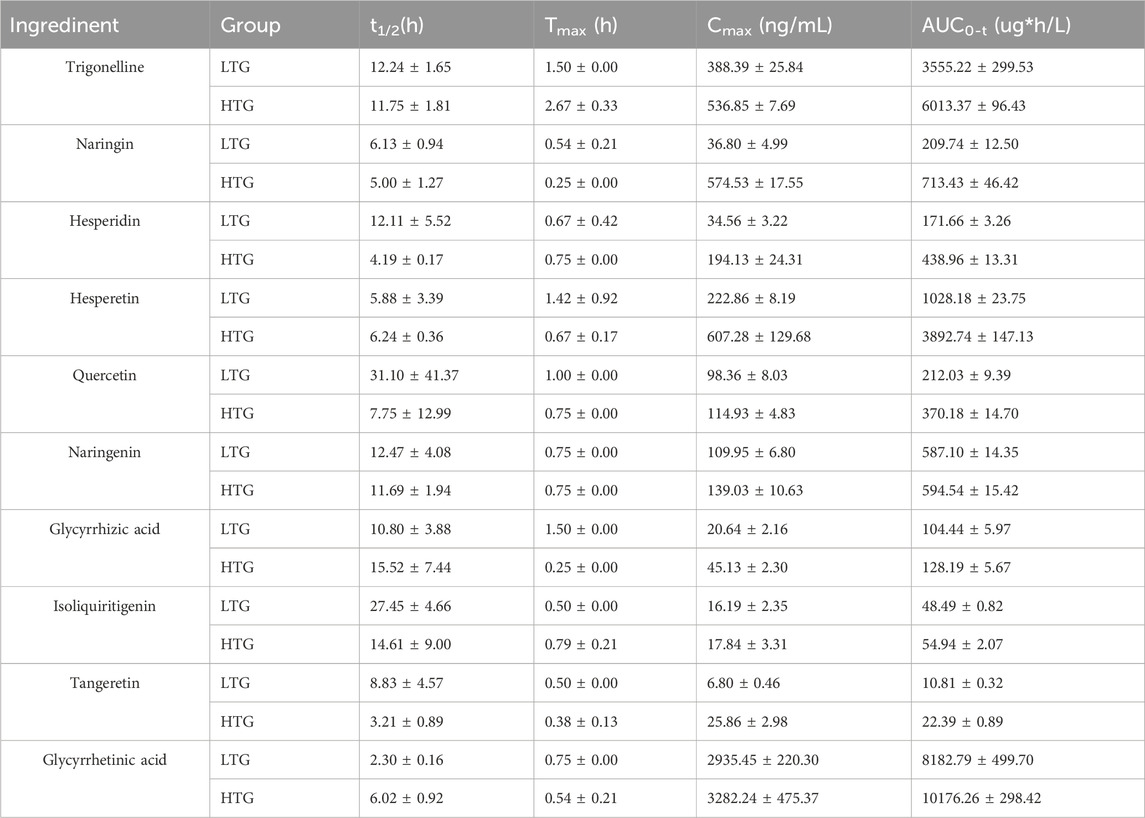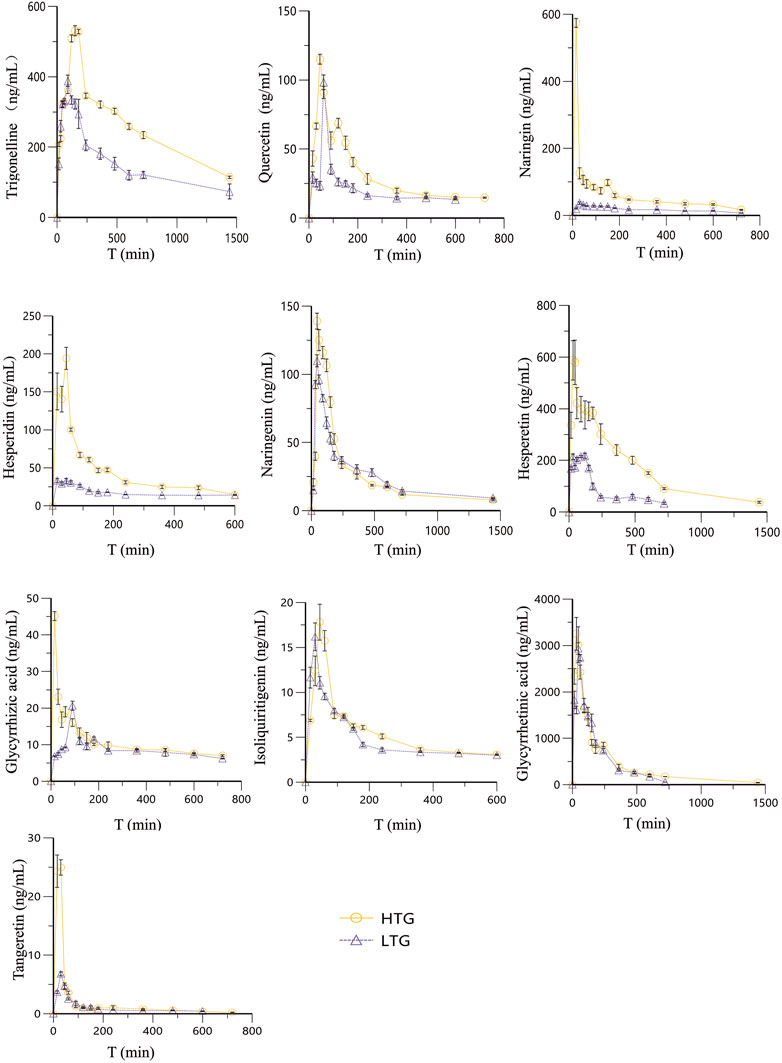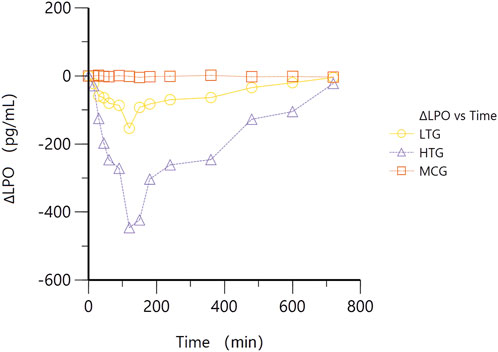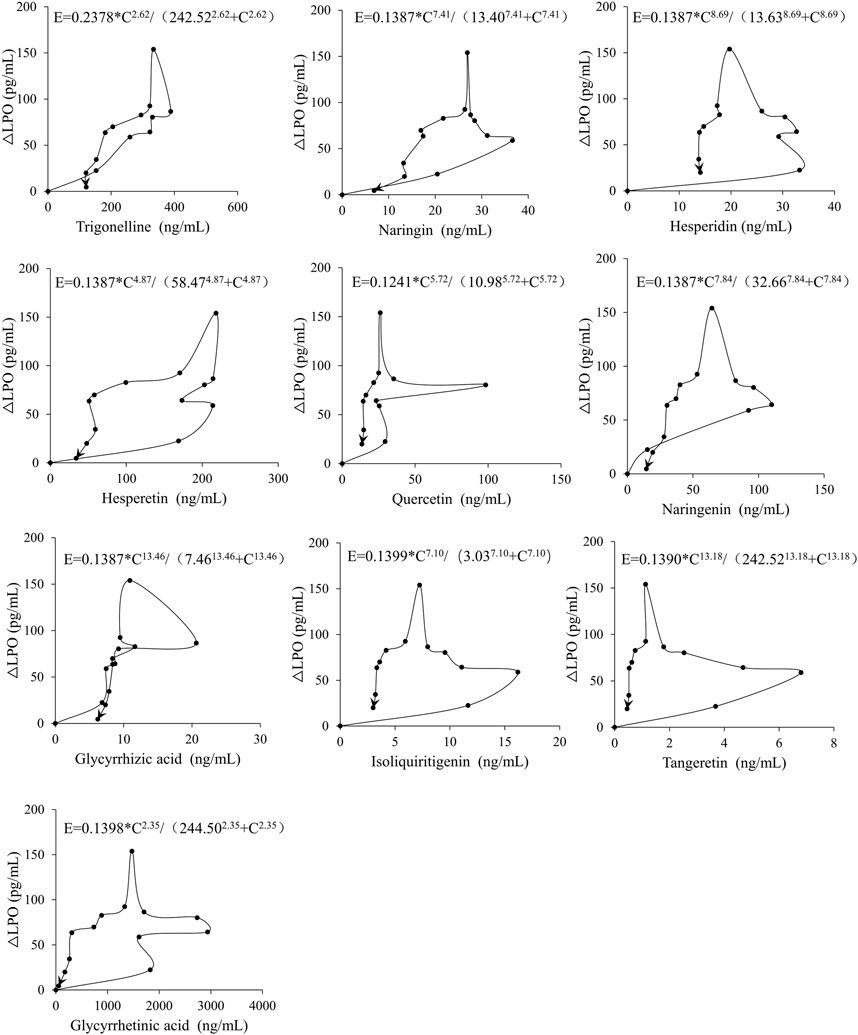- 1Laboratory of Chinese Medicine Preparation, Shandong Research Academy of Traditional Chinese Medicine, Jinan, China
- 2The Faculty of Medicine, Qilu Institute of Technology, Jinan, China
- 3Department of Pharmacology, School of Pharmaceutical Science, Shandong University, Jinan, China
- 4Shandong Medicine and Health Key Laboratory of Clinical Pharmacy, Department of Clinical Pharmacy, The First Affiliated Hospital of Shandong First Medical University, Shandong Provincial Qianfoshan Hospital, Shandong Engineering and Technology Research Center for Pediatric Drug Development, Jinan, China
- 5Research Center for Sectional and Imaging Anatomy, School of Basic Medical Science, Digital Human Institute, Shandong University, Jinan, Shandong, China
Background: Wendan Decoction (WDD) is a six-herb Chinese medicine recipe that was first mentioned in about 652 AD. It is frequently used to treat hyperlipidemic patients’ clinical complaints. According to reports, oxidative stress has a significant role in hyperlipidemia.
Purpose: There has not yet been a thorough pharmacokinetic-pharmacodynamic (PK-PD) examination of the clinical efficacy of WDD in the context of hyperlipemia-related oxidative stress. Therefore, the goal of this research is to explore the antioxidant essence of WDD by developing a PK-PD model, ordering to assure its implication in treating hyperlipidemia in medical practice.
Methods: The model rats of foodborne hyperlipidemia were established by feeding with high-fat feed, and the lipid-lowering effect of WDD was explored. The plasma drug concentration of rats at different doses were measured by UPL-MS/MS technology, and PK parameters were calculated using Phoenix WinNonlin 8.1 software. The level of lipid peroxide (LPO) in plasma at different time points was measured by enzyme labeling instrument. Finally, the PK-PD model was established by using Phoenix WinNonlin 8.1 software, to explore the lipid-lowering effect of WDD and the relation between the dynamic changes of chemical components and antioxidant effect.
Results: The findings suggested that, WDD can reduce the levels of triglyceride (TG), total cholesterol (TC), and low-density lipoprotein cholesterol (LDL-C) in plasma, and high-density lipoprotein cholesterol (HDL-C) was related to the dosage. Between the peak drug levels and the WDD’s maximal therapeutic response, there existed a hysteresis. WDD’s effect-concentration curves displayed a counterclockwise delaying loop. Alternatively, among the ten components of WDD, hesperetin, quercetin, naringenin and tangeretin might exert more significant effects in regulating the LPO levels in hyperlipidemic rats.
Conclusion: This study can be helpful for other investigators to study the lipid-lowering effect of WDD.
1 Introduction
Hyperlipidemia, sometimes also termed as dyslipidemia, refers to the higher levels of lipids and cholesterol in the blood plasma (Kramer, 2020). Low-density lipoprotein (LDL) cholesterol (bad cholesterol) and high-density lipoprotein (HDL) cholesterol (good cholesterol) regulate the balance in the blood. An imbalance in the levels of LDL-cholesterol and HDL-cholesterol may leads to the cardiovascular complexities including myocardial infarction or even heart attack (Karr, 2017). A well-documented data has described that, the appropriate levels of HDL-C have the ability to exert the shielding effects on the endothelial functions in the patients with hyperlipidemia and hypercholesterolemia (Memon et al., 1995). Hyperlipidemia can be caused as a result of several factors, most common of which include, unhealthy lifestyle, an imbalanced diet, stress, being overweight, being alcoholic, smoking, physical inactivity, etc. Genetic factor, like familial hypercholesterolemia (FH) can also contribute to the hyperlipidemia. FH is reported to affect about 1 in every 250 people, and individuals with FH have very high levels of LDL-cholesterol at a very young age. Such people have a very high risk of getting the stroke or myocardial infarction (Warnholtz et al., 2001; Ansar et al., 2011). Oxidative stress and inflammation are thought to cause the excessive lipid aggregation in the non-adipose tissues (Okon et al., 2007). Oxidative stress can be caused as a result of the excessive production of the different kinds of free radicals, notably reactive oxygen species (ROS), reactive nitrogen species (RNS), and so on (Elesber et al., 2007; Abu-Saleh et al., 2021). Oxidative stress has been documented to induce an abnormal lipid metabolism (Jeong et al., 2012). Thus, depending on its pathogenesis, oxidative stress has become a key therapeutic target to treat the hyperlipidemia.
Traditional Chinese medicine (TCM), with thousands of years of history, has a significant impact on the management of illnesses, and then it bases its therapeutic approach on a number of different components. Daidzein plays an important role to treat the type 2 diabetes (Das et al., 2018), scopoletin and naringin have a significant role in the regulation of insulin (Jia et al., 2019; Jang et al., 2020), and glycyrrhetinic acid and formononetin play roles in the treatment of hypertension (Zhang et al., 2019; Li et al., 2020). Because of the complexity of TCM and its preparations, its challenging to select molecules as detection indexes. Thus, for studying the pharmacokinetics of TCM medicines, a useful foundation was laid by LC-MS/MS technology (Ji et al., 2018; Lu et al., 2019; Wan et al., 2020). The pharmacokinetics of Ban-Xia (BX), Zhu-Ru (ZR), Chen-Pi (CP), Zhi-Shi (ZS), Gan-Cao (GC), Sheng-Jiang (SJ), and other single herbs have been reported previously (Lin et al., 2009; Xu and Cheng, 2011; Tang et al., 2018; Li et al., 2019), but these compounds could not represent the pharmacokinetics of complex compounds in TCM.
WDD is one of the top ten classic prescriptions of traditional Chinese medicine. WDD was originated from “Bei ji qian jin yao fang (Essential Recipes for Emergent Use Worth a Thousand Gold)” by Tang Sun Simiao (Zhang et al., 2022). It was one of the first 100 classic prescriptions released and composed of Pinellia ternata (BX), Bambusae Caulis in Taenias (ZR), Citri Reticulatae Pericarpium (CP), Aurantii Fructus (ZS), Glycyrrhizae Radix et Rhizome (GC), Zingiberis Rhizoma Recens (SJ). Clinical studies have proved that WDD has significant therapeutic effects on depression, dyslipidemia, schizophrenia, insomnia, Alzheimer’s disease and other nervous system disorders (Deng and Xu, 2017; Yan et al., 2017; Feng et al., 2019). This prescription is basically prescribed as an “expectorant” in clinical practice. Further, it is commonly used in clinical practice to treat the patients with gallbladder problems and phlegm disturbance such as neurosis, climacteric syndrome and epilepsy (Che et al., 2016; Jin et al., 2022). Previous studies have demonstrated the qualitative and quantitative determination of WDD based on LC-MS/MS technology. The main chemical components analyzed in WDD include flavonoids, alkaloids, coumarins and triterpenoids (Yang et al., 2017; Wang et al., 2021). Several reports have been made on the pharmacokinetics associated with certain key bioactive substances, such as liquiritigenin, isoliquiritigenin (Han et al., 2019), naringenin (Wang et al., 2020a), etc. Nevertheless, pharmacokinetic studies on the primary bioactive components of WDD are still lacking. Pharmacokinetic analyses of WDD’s primary bioactive ingredients will help to understand the dynamic process and action mechanism of the main bioactive components of WDD in vivo. To date there has not been a pharmacokinetic (PK) and pharmacodynamic (PD) study documented on the in vivo antioxidant activity of WDD.
In order to relate WDD-PK profiles to important therapeutic aspects and to provide guidance on the therapeutic usage of this herb in clinical settings, this work aims to build an in vivo PK-PD model. Which in turn will lay a foundation for other researchers to further investigate the PK-PD attributes of this potent traditional herb.
2 Materials and methods
2.1 Materials and instruments
Hesperidin (wkq20030407), tangeretin (wkq20041611), naringin (wkq21020606), isoliquiritigenin (wkq18033006), glycyrrhetinic acid (wkq16070701), glycyrrhizic acid (wkq16032502), were obtained from the Sichuan Weikeqi Biological Technology Co., Ltd. (Sichuan, China). Hesperetin (PS000219), Trigonelline (PS000427), were provided by Sichuan Pu Si Biological Technology Co., Ltd. (Sichuan, China). Quercetin (100081–200406), and furosemide (as an internal standard), (100544–201503) were taken from the China Institute for Identification of Pharmaceutical and Biological Products (Beijing, China). The purity of all reference substances was above 98%. The structures of ten components of WDD are displayed in Figure 1.
Lipid peroxide (LPO) kit (EDL202107257) was supplied by Shanghai Yubo Biotechnology Co., LTD. (Shanghai, China). TG kit (20,210,723), LDL-C kit (20,210,723), HDL-C kit (20,210,723), and TC kit (20,210,723) were taken from Nanjing Jiancheng Bioengineering Institute (Nanjing, China). Acetonitrile and formic acid (chromatographic grade), were given by Fisher Scientific and Thermo Fisher Scientific Co., Ltd., respectively, whereas water was deionized water. High-fat blood feed (76.8% basic feed, 10% lard, 0.5% sodium cholate, 2.5% cholesterol, 10% egg yolk powder, 0.2% propylthiouracil) was purchased from Jinan Pengyue Experimental Animal Breeding Co., Ltd. (Jinan, China). Every single herb was purchased from Bozhou market (Anhui, China), and identified by Jin Guangqian, researcher of Shandong Academy of Traditional Chinese Medicine.
Mass spectrometry measurement was employed to Vanquish purification LC system, and triple quadrupole mass spectrometer (Thermo Scientific, United States), furnished with heated-electrospray ionization apparatus. Method setting, data acquisition and processing, and reporting were conducted using a Thermo Scientific Xcalibur software. Alpha1-4LSCplus freeze dryer (Germany CHRIST Freeze Dryer Co., LTD.). N-2110 rotary evaporator (Tokyo Physical and Chemical Instrument Co., LTD.). Xmark microplate reader (Bio-Rad Company), high-speed centrifuge HC-2518 (Anhui Zhongke Zhongjia Scientific Instrument Co., LTD.).
This research scheme has been approved by the Ethics Committee of Shandong Academy of Traditional Chinese Medicine (NO. SDZYY202201015). Animal-related experiments in this study were carried out according to the guideline “Guidance for Nonclinical Pharmacokinetics of Medicinal Products”.
2.2 Preparation of WDD extract
10 g of pinellia ternata, 10 g of bran fried Fructus aurantii, 20 g of ginger, 10 g of raw bamboo, 5 g of fried licorice, 15 g of raw orange peel and 840 mL water, were accurately measured. Then, these ingredients were soaked for 30 min, decocted twice (2 h each time), filtered, combined, evaporated and concentrated. The above operation was repeated to obtain the extract of WDD. The resultant WDD extract was stored in a refrigerator at −20°C, which was filtered with 0.22 μm microporous membrane before analysis.
2.3 Development of hyperlipidemia rat model
50 SPF grade male SD rats (4 weeks, 180–200 g) were supplied by Jinan Pengyue Experimental Animal Breeding Co., LTD. (certification no. SCXK (LU) 20,190,003). The Study was approved by the Ethics Committee of The First Affiliated Hospital of Shandong First Medical University and Shandong Provincial Qianfoshan Hospital Prior to being utilized in experiments, rats were kept for 7 days in an environmentally stable house (25°C ± 2°C, relative humidity 50% ± 5%, and 12 h light/dark cycle) having complete water accessibility, pathogen-free environment, and adaptive food. Rats with healthy blood lipid profiles were chosen after 1 week during adaptable feeding. Six of them were chosen to serve as NCG rats, and they were given a basic feed meal. The rest of the rats (to develop a hyperlipidemia model) were given a high-fat diet (HFD) over a 12-week period.
Afterwards, following a 12-h fasting, blood was drawn from each animal’s mandibular vein and lipid panels (LDL-C, HDL-C, TC, and TG levels) were assessed to determine whether hyperlipidemia had been successfully induced. The rats with significant differences in body weights and blood lipid indexes were separated into a model group, a low-dose WDD group (LTG) and a high-dose WDD group (LTG) (n = 6 each). Fasting blood samples were taken to determine blood lipid indexes 12 h after administration.
2.4 Animal testing and samples gathering
Four groups (NCG, MCG, LTG, and HTG) of successfully modeled rats were established, with six rats in each group. LPO values of all the rats were assessed prior to therapy, and utilized as the baseline. Both the NCG and MCG groups received an equivalent amount of normal saline, whereas rats in the LTG and HTG groups received 2.2 g/100 g and 6.6 g/100 g of WDD by gavage, respectively. Before and after the administration, about 0.5 mL of blood was taken from orbital venous plexus at around 0.25, 0.5, 0.75, 1, 1.5, 2, 2.5, 3, 4, 6, 8, 10, 12, 24 h, and placed in a 1.5 mL heparinized centrifuge tube. Afterwards, centrifugation was carried out for 10 min at 6,000 rpm and the supernatant (200 μL) was divided into two separate storage tubes for PK and PD studies, and stored at −80°C.
2.5 Sample preparation and analysis
2.5.1 LC-MS/MS analytical conditions
2.5.1.1 Chromatographic conditions
Thermo Scientific Hypersil C18 analytical column (particle size: 1.9 µm, length: 100 mm, and diameter: 2.1 mm) was employed. Column operational conditions were like so, column temperature: 30°C, autosampler temperature: 4°C, whereas the flow rate: 0.3 mL/min. Injection volume: 3 μL, and mobile phase: aqueous solution containing 0.1% formic acid aqueous solution (A) and acetonitrile (B). Elution gradient: 0–0.5 min, 5% B; 0.5–2 min, 5%–8% B; 2–2.1 min, 40% B; 2.1–4 min, 40%–50% B; 4–6 min, 50%–60% B; 6–6.1 min, 60%–70% B; 6.1–8 min, 70%–80% B; 8–8.1 min, 80%–5% B; 8.1–10 min, 5% B.
2.5.1.2 Mass spectrometry conditions
Electrospray ion source (ESI) was used for mass spectrometry detection and analysis, both in positive and negative ion patterns. Nitrogen was kept as both of the auxiliary and sheath gas. The capillary temperature was 345°C, the atomizer temperature was 350°C, and the electrospray voltage was 3800 V. The mass spectrometry data for the 10 compounds and the internal standard (IS) are shown in Table 1.
2.5.2 Bioanalytical method validation
An appropriate amount of furosemide (IS) was taken, and furosemide solution with a concentration of 500 ng/mL was made in 50% acetonitrile. We prepared 2 mg/mL stock solutions of trigonelline, naringin, hesperidin, hesperetin, quercetin, naringenin, glycyrrhizic acid, isoliquiritigenin, tangeretin, and glycyrrhetinic acid in 50% acetonitrile. The above stock solutions were precisely pipetted and diluted with 50% acetonitrile solution, to make a mixture of working solutions, with concentrations: 60–6,000 ng/mL of trigonelline, 6–600 ng/mL of naringin, 12–1200 ng/mL of hesperidin, 30–3,000 ng/mL of hesperetin, 13–1,300 ng/mL of quercetin, 7–700 ng/mL of naringenin, 5–500 ng/mL of glycyrrhizic acid, 3–300 ng/mL of isoliquiritigenin, 0.2–20 ng/mL of tangeretin, and 30–3,000 ng/mL of glycyrrhetinic acid, respectively. The above mixed working solution was precisely measured and diluted with 50% acetonitrile into 4 different concentrations of Quality Control sample (QC) solutions (lower limit of quantification: low concentration: medium concentration: high concentration = 1:3:50:75). The precision, accuracy, linearity, recovery, and stability of the aforementioned solutions were then verified, in accordance with the standards for the verification of biological sample quantitative analytical methods.
2.5.3 Sample preparation
After accurately measuring 100 μL of plasma, 10 μL of the QC solution or the IS solution was supplemented, and the blend was vortexed for 30 s. Afterward, 300 μL of acetonitrile (as protein precipitant) was added, vortexed for 1 min, and then centrifuged (10 min at 12000 r/min). Finally, the supernatant was taken and stored for testing.
2.6 PK research
The standard curves produced for every specimen batch were used to calculate the trigonelline, naringin, hesperidin, hesperetin, quercetin, naringenin, glycyrrhizic acid, isoliquiritigenin, tangeretin and glycyrrhetinic acid plasma concentrations. The dose, plasma concentration and time after administration were imported into the NCA (Noncompartmental Analysis) module of Phoenix 8.1 to obtain the pharmacokinetic parameters. The Phoenix Model module of Phoenix software was used to establish the atrioventricular model of the drug. Akaike Information Criterion (AIC) rules were used to calculate the optimal PK model.
2.7 PK–PD research
Employing specialized ELISA kits and following the specified instructions, the values of plasma LPO were monitored over time. In order to assist the PK-PD modeling, LPO values were utilized to determine changes associated with treatment in the LTG via the given Eq. 1 (Huang et al., 2020):
(‘ΔLPO’ refers to the variation in LPO from the initial levels)
Above PK model and a Sigmoid Emax model (Eq. 2) were used, to establish a PK-PD model on the basis of concentrations of plasma and LPO levels. A preliminary model of the PK-PD interaction was developed using the plasma concentrations of LPO as well as the 10 WDD ingredients in LTG rats.
Where ‘E’ denotes the change in plasma LPO levels, ‘C’ indicates the concentration to drug effect, ‘Emax’ corresponds to the highest possible drug effect, ‘ED50γ’ indicates the dose that generates 50% of the Emax, and ‘γ’ signifies the halfway slope of the curve (an indicator of the concentration-effect correlation).
3 Results
3.1 Hyperlipidemia rat model study
Following 12 weeks of HFD feeding, the rats plasma lipid levels were determined. The findings demonstrated that, the model rats had much higher levels of lipids, as compared with the controls (Table 2). In particular, MCG rats were found with considerably higher levels of TC and TG than NCG rats (p < 0.01), whereas MCG rats were also observed with higher levels of LDL-C than NCG (p < 0.05), and lower levels of HDL-C than NCG (p < 0.05). Hence, these results verified the successful establishment of our hyperlipidemia rat model.
After administration of the low dose of WDD, the rats showed significant differences in weight, TG, TC and LDL-C levels in contrast to the model group rats, but the changes in HDL-C were not significant and did not differ significantly. After the administration of high-dose of WDD, the four lipid parameters examined varied considerably from the model group rats. These findings indicated that, WDD may achieve lipid-lowering effects by lowering plasma TC, TG and LDL-C levels, however no notable variations between HTG and LTG were seen (Table 3). Therefore, LTG group was selected to construct a PK-PD model.
3.2 Methodology study
3.2.1 Specificity
The lower limit of quantitation (LLOQ) refers to the signal-to-noise ratio of exactly 10, where an analyte can be reliably quantified (Trivedi et al., 2004; Duggan, 2019). The LLOQ and the blank plasma of IS rats were measured through the specificity analysis of rat blank plasma (Figure 2). The retention times of trigonelline, naringin, hesperidin, hesperetin, quercetin, naringenin, glycyrrhizic acid, isoliquiritigenin, tangeretin, glycyrrhetinic acid and furosemide were 0.84, 3.71, 3.74, 3.75, 4.03, 4.51, 4.55, 4.79, 6.03, 8.29, and 4.49 min respectively. The chromatographic peak patterns of each compound were good, and there was no interference from other impurity peaks in the plasma samples.
3.2.2 Standard curve and linear range
The linear regression equation and range of each substance to be measured were obtained by preparing 8 plasma solutions of mixed control at different concentration levels. The results indicated that, the correlation coefficient (r2) of every single compound was >0.99, indicating that the linear relationship was good within this concentration range. Standard curves and linear ranges of 10 compounds were shown in Table 4. UPLC-MS chromatograms of 10 components in WDD and Furosemide were shown in Figure 2.
3.2.3 Precision and accuracy
The precision and accuracy (both intra- and inter-day) of QC samples of the substance to be measured were investigated. The results showed that, the intra-day precision (RSD) was 1.35%–19.33%, and the inter-day precision (RSD) was 1.64%–14.14%. The intra-day accuracy (RE) was −12.50%-19.80%, and the inter-day accuracy (RE) was −12.03%-18.22% (Table 5), indicating that both of the precision and accuracy of the following procedure were good.
3.2.4 Extraction recovery and matrix effect
The results showed that, the extraction recoveries were greater than 89.23%, indicating that acetonitrile could be used as the extraction solvent for the above compounds, and the interference of other endogenous components could be excluded. The matrix effects of the 10 compounds ranged from 94.49% to 106.30%, and the RSD values ranged from 0.56% to 12.05%, indicating that, no interference of other endogenous components was there in the matrix of blood.
3.2.5 Stability
The stability results of QC specimens (at 4 different concentrations) showed that, the short-term stability and injector stability (RSD) of the 10 compounds to be tested ranged from 1.66% to 18.51%. Indicating that, the samples to be tested were stable within 2 h at room temperature and within 24 h in the injector (4°C). The RSD values of long-term stability and freeze-thaw cycle stability were between 1.28% and 19.99%, and samples were stable after three repeated freeze-thaw cycles, suggesting that the samples to be tested could be stored at −80°C for 14 days, as detailed in Table 6.
3.3 PK profiles in hyperlipidemia rats
After the rats were given different doses of WDD by gavage, the established LC-MS/MS method was applied to quantitatively analyze the 10 substances to be measured in the rat’s plasma. The blood drug concentrations were obtained at different time points and the drug-time curves of each compound were shown in Figure 3. Phoenix 8.1 software was used to calculate the non-compartment model to obtain its pharmacokinetic parameters (Table 7).
The results showed that, 10 components of WDD could be detected in plasma at 0.25 h. Equivalent dose: from the aspect of time of reaching the peak, hesperetin and isoliquiritigenin have the shortest time of reaching the peak, only 0.5 h, and the components with the longest time of reaching the peak are glycyrrhizic acid and trigonelline, 1.5 h. From the perspective of half-life, the half-life of glycyrrhetinic acid was the shortest, only 2.3 h, and that of quercetin was the longest, up to 31.1 h. High dose: the peak time of hesperetin and isoliquiritigenin was the shortest, only 0.25 h, and the component with the longest peak time was trigonelline, up to 2.67 h. In terms of half-life, hesperetin has the shortest half-life, only 3.21 h, and glycyrrhizic acid has the longest time, up to 15.52 h. In terms of the level of exposure in vivo, the area under the curve (AUC) of glycyrrhetinic acid in rat’s plasma was the largest at both doses, indicating that it has good bioavailability. The ideal biochemical processing of these 10 substances in rats was better defined by the two-compartment PK model, according to AIC values (Table 8).
3.4 PD research
The average change in LPO levels in WDD treatment groups was evaluated by means of the effect-time curve for MCG, LTG and HTG groups (Figure 4). After treatment with WDD, the LPO levels in the two treatment groups showed a trend of decreasing first and then increasing, indicating that WDD can inhibit the level of LPO. The lowest level of LPO in the treatment group was observed in 2 h, whereas the LPO level in the high-dose group was severely inhibited. Thus, it is suggested that the inhibition of LPO level by WDD may be related to the dose. It can be seen that the LPO level in the WDD treatment group is significantly decreased than that at the beginning, which also proves the inhibitory effect of WDD on the level of LPO. Indicating that, this reduction could be one of the mechanisms of WDD to help in treating the hyperlipidemia.
3.5 PK-PD research
The PK-PD simulation was then carried out by employing the final collected data. The drug effect-concentration curves of ten components are shown in Figure 5. A sigmoid Emax model provided the most accurate descriptions of ten substances and LPO concentrations, with calculated parameters for trigonelline, naringin, hesperidin, hesperetin, quercetin, naringenin, glycyrrhizic acid, isoliquiritigenin, tangeretin and glycyrrhetinic acid, were determined using this model. Table 8 displays the final quantified PK-PD formulas for each group that incorporate drug levels and LPO effects.
4 Discussion
Hyperlipidemia is a kind of metabolic disorder caused by defective lipid metabolism in the body, which can cause systemic and cardiovascular disorders, i.e., atherosclerosis (Tannock, 2008; Nofer, 2010; Tietge, 2014; Navar-Boggan et al., 2015; Zhao et al., 2018; Suh et al., 2022). High fat diet intake and improper lipid metabolism could both contribute to the development of hyperlipidemic disorders (Joy et al., 2007; Bai et al., 2015; Matey-Hernandez et al., 2018; Rodríguez-Borjabad et al., 2021). In this study, a hyperlipidemia rat model was established, so as to study the PK-PD characteristics of the ten components of WDD. The in vivo PK-PD studies are considered to be extremely crucial in constructing the new drug molecules, in order to direct their clinical application (Wang et al., 2020b). PK analysis gives an insight into the several attributes of a drug, including drug-plasma concentration, half-life, the onset of action, etc. (Chaudhary and Dion, 2013). On the other hand, PD analysis analyzes the drug effect and the mechanism of action of a new drug (Cui et al., 2022). In order to understand the connection of particular components in a complex preparation with efficacy or toxicity, the precise study of the PK-PD relationship is valuable, Flavonoids have been proven to exert the protective effects, including antioxidant and anti-inflammatory effects, by eliminating the free radicals (Rajendran et al., 2004; Nauser and Gebicki, 2019; Kejík et al., 2021). Hence, it is been proposed that flavonoids and associated metabolites contain antioxidant effects and can prevent oxidative injury brought on by hyperlipidemia (Pietta, 2000; Sun et al., 2021). WDD components, including naringin, hesperidin, hesperetin, quercetin, naringenin, isoliquiritigenin, and tangeretin contain flavonoids as principal bioactive compounds. In addition, WDD also contains active alkaloids, such as trigonelline, glycyrrhizic acid and glycyrrhetinic acid.
Several studies have confirmed that these components have different degrees of lipid-lowering effects. Naringin has a strong effect on reducing lipids and protecting liver in hyperlipidemia mice (Yu et al., 2022). Hesperidin can reduce altered redox homeostasis in experimental hyperlipidemia rat models (Kumar et al., 2020). Compared with the control group, the body weight, obesity index, serum TC, TG, liver TC, TG and free fatty acid levels of hyperlipidemia hamsters treated with hesperetin were significantly decreased (Shi et al., 2023). Available evidence from randomized controlled trials suggests that quercetin supplementation does not have any clinically relevant effect on plasma lipids, except for a significant reduction in triglycerides at doses above 50 mg/day (Sahebkar, 2017). Supplementation with the natural compound naringenin can directly act on high cholesterol induced liver damage (Chtourou et al., 2015). Citrus flavonoids such as tangeretin have been shown to play a significant role in the treatment of dyslipidemia, insulin resistance, hepatic steatosis, obesity and atherosclerosis (Mulvihill et al., 2016). Trigonelline is reported to have a variety of biological activities, such as protecting the heart and liver, treating high blood sugar, hypercholesterolemia, nerve and hormone disorders, and cancer (Mohamadi et al., 2018). Glycyrrhizic acid can increase HDL and has anti-atherosclerotic properties (Eu et al., 2010).
The in vivo PK and PD parameters of such components in Hyperlipidemic environment have not yet been examined. Therefore, we constructed the current investigation as an in vivo PK-PD evaluation of trigonelline, hesperidin, hesperetin, naringenin, naringin, glycyrrhizic acid, isoliquiritigenin, tangeretin, quercetin, and glycyrrhetinic acid in hyperlipidemia. Studies have approved that, malondialdehyde (MDA), and such other polyunsaturated fatty acids can be used to determine the oxidative stress and LPO in disease process related to hyperlipidemia (Ayala et al., 2014; Li et al., 2018). The rise of LPO level is the result of the automatic oxidation of polyunsaturated fatty acids, which can promote the production of MDA and other toxic compounds. In this study, we choose LPO level as the main PD index, measured by model animals with significant elevations in plasma (Figure 4), which is in line with previous studies (Chang et al., 2011; Guo et al., 2022).
Earlier in this study, we tested methanol and acetonitrile as organic solvents for the removal of protein macromolecules, and finally found that acetonitrile was superior to methanol. The plasma matrix effect and elution durations of trigonelline, naringin, hesperidin, hesperetin, quercetin, naringenin, glycyrrhizic acid, isoliquiritigenin, tangeretin, and glycyrrhetinic acid were assessed, and the results showed that these plasma components are optimally segregated using 0.1% formic acid in water and acetonitrile. Then, using a rat model of hyperlipidemia, we carried out PK and PD study on the WDD components.
All the rats in LTG and HTG WDD-treated groups were analyzed in parallel with each other, correlating the plasma concentrations of trigonelline, naringin, hesperidin, hesperetin, quercetin, naringenin, glycyrrhizic acid, isoliquiritigenin, tangeretin and glycyrrhetinic acid. Major PK variables were analyzed using UPLC-MS such as t1/2, Tmax, Cmax and AUC0-t. The LPO results determined by PD analysis were combined with treatment-related changes in the LTG and HTG to establish a PK-PD model. Rats in the HTG group showed substantially higher Cmax and AUC0-t for each of the 10 tested WDD ingredients than those in the LTG group. As compared with LTG group, t1/2 of glycyrrhizic acid and glycyrrhetinic acid in HTG group were significantly prolonged, and Tmax was significantly decreased, suggesting that the intestinal absorption rate of these two substances might be accelerated with the increase of dosage, and prolonged metabolic time in the body. The t1/2 of hesperidin, quercetin, isoliquiritigenin, and tangeretin were significantly shortened and Tmax was significantly decreased, indicating that the intestinal absorption and metabolism were expediated with increasing dose. The alterations in the gut flora brought on by oxidative stress and hyperlipidemia might help the body to absorb glycyrrhizic acid, glycyrrhetinic acid, hesperidin, quercetin, isoliquiritigenin and tangeretin. For trigonelline, hesperetin and naringenin, different doses did not cause significant changes in t1/2 and Tmax. The pharmacokinetic and pharmacodynamic relevance of the 10 major WDD compounds was investigated, based on trends in concentration as well as in LPO values. Subsequent results indicated that, ED50 values of isoliquiritigenin, glycyrrhizic acid, quercetin, naringin, hesperidin, naringenin, hesperetin were smaller. It indicated that, each component has a greater influence on the levels of LPO. These results suggest that, flavonoids are the main active components of WDD in lowering blood lipids. Our previous study has proved the shielding effects of WDD on HUVEC cells damage by palmitic-acid (Xu et al., 2023). Whereas, our present study has validated the lipid-lowering nature of the potent WDD in rats’ plasma. Suggesting that, both studies may provide a foundation for other researchers to further investigate the antihyperlipidemic effects of WDD.
5 Conclusion
In the interest of better comprehending the antioxidant activity of this TCM formulation, we examined the PK and PD attributes of 10 major components of WDD (trigonelline, naringin, hesperidin, hesperetin, quercetin, naringenin, glycyrrhizic acid, isoliquiritigenin, tangeretin and glycyrrhetinic acid) in vivo. So as to assess the efficacy of the exclusive dosage of WDD in decreasing the LPO blood levels in the hyperlipidemia in vivo, we effectively built the sigmoid Emax PK-PD model. The consequent results of this study may provide data for ensuing investigations of PK/PD properties of WDD, in order to direct its therapeutic use in medical settings.
Data availability statement
The original contributions presented in the study are included in the article/supplementary material, further inquiries can be directed to the corresponding authors.
Author contributions
NX: Conceptualization, Data curation, Formal Analysis, Funding acquisition, Investigation, Methodology, Project administration, Resources, Software, Supervision, Validation, Visualization, Writing–original draft, Writing–review and editing. MI: Conceptualization, Data curation, Formal Analysis, Funding acquisition, Investigation, Methodology, Project administration, Resources, Software, Visualization, Writing–original draft, Writing–review and editing. YS: Conceptualization, Data curation, Formal Analysis, Funding acquisition, Investigation, Methodology, Project administration, Resources, Visualization, Writing–original draft, Writing–review and editing. PeW: Conceptualization, Data curation, Formal Analysis, Investigation, Methodology, Project administration, Software, Visualization, Writing–original draft, Writing–review and editing. LM: Conceptualization, Data curation, Formal Analysis, Investigation, Methodology, Software, Visualization, Writing–original draft, Writing–review and editing. PiW: Conceptualization, Data curation, Formal Analysis, Funding acquisition, Investigation, Methodology, Project administration, Resources, Software, Supervision, Validation, Writing–original draft, Writing–review and editing. HD: Conceptualization, Data curation, Formal Analysis, Investigation, Methodology, Software, Validation, Visualization, Writing–original draft, Writing–review and editing. MSh: Conceptualization, Data curation, Formal Analysis, Funding acquisition, Investigation, Methodology, Project administration, Resources, Software, Supervision, Validation, Visualization, Writing–original draft, Writing–review and editing. H-yS: Conceptualization, Data curation, Formal Analysis, Funding acquisition, Investigation, Methodology, Project administration, Resources, Software, Supervision, Writing–original draft.
Funding
The author(s) declare financial support was received for the research, authorship, and/or publication of this article. Funding Information: Key Project of Shandong Natural Science Foundation (ZR2020KH017); National Natural Science Foundation Project (82,074,052); New 20 clauses universities in Jinan City Introduce Innovation Team Projects (202,333,021); Key Projects of Traditional Chinese Medicine Technology Projects in Shandong Province (2021Z048); Shandong Province Science and Technology Small and Medium Enterprises Innovation Ability Enhancement Project (2022TSGC1057); Jinan Science and Technology Small and Medium Enterprises Innovation Ability Enhancement Project (2022TSGC1057); Shandong Province Traditional Chinese Medicine Technology Project (Z-2023012).
Conflict of interest
The authors declare that the research was conducted in the absence of any commercial or financial relationships that could be construed as a potential conflict of interest.
Publisher’s note
All claims expressed in this article are solely those of the authors and do not necessarily represent those of their affiliated organizations, or those of the publisher, the editors and the reviewers. Any product that may be evaluated in this article, or claim that may be made by its manufacturer, is not guaranteed or endorsed by the publisher.
References
Abu-Saleh, N., Yaseen, H., Kinaneh, S., Khamaisi, M., and Abassi, Z. (2021). Combination of hyperglycaemia and hyperlipidaemia induces endothelial dysfunction: role of the endothelin and nitric oxide systems. J. Cell. Mol. Med. 25 (4), 1884–1895. doi:10.1111/jcmm.15787
Ansar, S., Koska, J., and Reaven, P. D. (2011). Postprandial hyperlipidemia, endothelial dysfunction and cardiovascular risk: focus on incretins. Cardiovasc. Diabetol. 10, 61. doi:10.1186/1475-2840-10-61
Ayala, A., Muñoz, M. F., and Argüelles, S. (2014). Lipid peroxidation: production, metabolism, and signaling mechanisms of malondialdehyde and 4-hydroxy-2-nonenal. Oxidative Med. Cell. Longev. 2014, 360438. doi:10.1155/2014/360438
Bai, J., Zheng, S., Jiang, D., Han, T., Li, Y., Zhang, Y., et al. (2015). Oxidative stress contributes to abnormal glucose metabolism and insulin sensitivity in two hyperlipidemia models. Int. J. Clin. Exp. Pathology 8, 13193–13200.
Chang, C.Ju, Tzeng, T. F., Liou, S. S., Chang, Y. S., and Liu, I. M. (2011). Kaempferol regulates the lipid-profile in high-fat diet-fed rats through an increase in hepatic PPARα levels. Planta Medica. 77, 1876–1882. doi:10.1055/s-0031-1279992
Chaudhary, H. R., and Dion, R. B. (2013). The single dose poloxamer 407 model of hyperlipidemia; systemic effects on lipids assessed using pharmacokinetic methods, and its effects on adipokines. J. Pharm. Pharm. Sci. 16 (1), 65–73. doi:10.18433/j37g7m
Che, Y., Yao, K., Xi, Y., Chen, Z., Li, Y., Yu, N., et al. (2016). Wendan decoction for treatment of schizophrenia: a systematic review of randomized controlled trials. Chin. J. Integr. Med. 22, 302–310. doi:10.1007/s11655-015-2047-z
Chtourou, Y., Slima, A. B., Makni, M., Gdoura, R., and Fetoui, H. (2015). Naringenin protects cardiac hypercholesterolemia-induced oxidative stress and subsequent necroptosis in rats. Pharmacol. Rep. 67 (6), 1090–1097. doi:10.1016/j.pharep.2015.04.002
Cui, M., Zhu, F., Yin, Y., Sui, Y., Yan, X., and Chen, T. (2022). Influence of gegenqinlian decoction on pharmacokinetics and pharmacodynamics of atorvastatin calcium in hyperlipidemic rats. Eur. J. drug metabolism Pharmacokinet. 47 (1), 117–126. doi:10.1007/s13318-021-00738-5
Das, D., Sarkar, S., Bordoloi, J., Wann, S. B., Kalita, J., and Manna, P. (2018). Daidzein, its effects on impaired glucose and lipid metabolism and vascular inflammation associated with type 2 diabetes. BioFactors Oxf. Engl. 44, 407–417. doi:10.1002/biof.1439
Deng, H., and Xu, J. (2017). Wendan decoction (Traditional Chinese medicine) for schizophrenia. Cochrane database Syst. Rev. 6, CD012217. doi:10.1002/14651858.CD012217.pub2
Duggan, J. X. (2019). Quantification below the LLOQ in regulated LC-MS/MS assays: a review of bioanalytical considerations and cautions. Bioanalysis 11 (8), 797–814. doi:10.4155/bio-2018-0261
Elesber, A. A., Redfield, M. M., Rihal, C. S., Prasad, A., Lavi, S., Lennon, R., et al. (2007). Coronary endothelial dysfunction and hyperlipidemia are independently associated with diastolic dysfunction in humans. Am. heart J. 153 (6), 1081–1087. doi:10.1016/j.ahj.2007.03.007
Eu, C. H., Lim, W. Y., Ton, S. H., and bin Abdul Kadir, K. (2010). Glycyrrhizic acid improved lipoprotein lipase expression, insulin sensitivity, serum lipid and lipid deposition in high-fat diet-induced obese rats. Lipids Health Dis. 9, 81. doi:10.1186/1476-511X-9-81
Feng, W., Ye, X., Lv, H., Hou, C., and Chen, Y. (2019). Wendan decoction for dyslipidemia: protocol for a systematic review and meta-analysis. Medicine 98, e14159. doi:10.1097/MD.0000000000014159
Guo, Z., Ali, Q., Abaidullah, M., Gao, Z., Diao, X., Liu, B., et al. (2022). High fat diet-induced hyperlipidemia and tissue steatosis in rabbits through modulating ileal microbiota. Appl. Microbiol. Biotechnol. 106, 7187–7207. doi:10.1007/s00253-022-12203-7
Han, Y. J., Kang, B., Yang, E. J., Choi, M. K., and Song, I. S. (2019). Simultaneous determination and pharmacokinetic characterization of glycyrrhizin, isoliquiritigenin, liquiritigenin, and liquiritin in rat plasma following oral administration of Glycyrrhizae Radix extract. Mol. (Basel, Switz. 24, 1816. doi:10.3390/molecules24091816
Huang, P., Tang, Y., Li, C., et al. (2020). Correlation study between the pharmacokinetics of seven main active ingredients of Mahuang decoction and its pharmacodynamics in asthmatic rats. J. Pharm. Biomed. Anal. 183, 113144. doi:10.1016/j.jpba.2020.113144
Jang, J. H., Park, J. E., and Han, J. S. (2020). Scopoletin increases glucose uptake through activation of PI3K and AMPK signaling pathway and improves insulin sensitivity in 3T3-L1 cells. Nutr. Res. (New York, N.Y.) 74, 52–61. doi:10.1016/j.nutres.2019.12.003
Jeong, K., Monica, M., Sruti, C., and Michael, J. (2012). Role of lipotoxicity in endothelial dysfunction. Heart Fail. 8 (4), 589–607. doi:10.1016/j.hfc.2012.06.012
Ji, B., Zhao, Y., Yu, P., Yang, B., Zhou, C., and Yu, Z. (2018). LC-ESI-MS/MS method for simultaneous determination of eleven bioactive compounds in rat plasma after oral administration of Ling-Gui-Zhu-Gan Decoction and its application to a pharmacokinetics study. Talanta 190, 450–459. doi:10.1016/j.talanta.2018.08.020
Jia, B., Wang, Y., Yu, G., Cheng, Y., Yang, C., Cao, F., et al. (2019). Naringenin ameliorates insulin resistance by modulating endoplasmic reticulum stress in hepatitis C virus-infected liver. Biomedecine Pharmacother. 115, 108848. doi:10.1016/j.biopha.2019.108848
Jin, Q., Li, J., Chen, G. Y., Wu, Z. Y., Liu, X. Y., Liu, Y., et al. (2022). Network and experimental Pharmacology to decode the action of wendan decoction against generalized anxiety disorder. Drug Des. Dev. Ther. 16, 3297–3314. doi:10.2147/DDDT.S367871
Joy, T., Keogh, H. M., Hadigan, C., Lee, H., Dolan, S. E., Fitch, K., et al. (2007). Dietary fat intake and relationship to serum lipid levels in HIV-infected patients with metabolic abnormalities in the HAART era. AIDS Lond. Engl. 21, 1591–1600. doi:10.1097/QAD.0b013e32823644ff
Karr, S. (2017). Epidemiology and management of hyperlipidemia. Am. J. Manag. care 23 (9), S139–S148.
Kejík, Z., Kaplánek, R., Masařík, M., Babula, P., Matkowski, A., Filipenský, P., et al. (2021). Iron complexes of flavonoids-antioxidant capacity and beyond. Int. J. Mol. Sci. 22, 646. doi:10.3390/ijms22020646
Kramer, A. (2020). An overview of the beneficial effects of exercise on health and performance. Adv. Exp. Med. Biol. 1228, 3–22. doi:10.1007/978-981-15-1792-1_1
Kumar, R., Akhtar, F., and Rizvi, S. I. (2020). Hesperidin attenuates altered redox homeostasis in an experimental hyperlipidaemic model of rat. Clin. Exp. Pharmacol. Physiol. 47 (4), 571–582. doi:10.1111/1440-1681.13221
Li, L.-L., Cui, Y., Guo, X. H., Ma, K., Tian, P., Feng, J., et al. (2019). Pharmacokinetics and tissue distribution of gingerols and shogaols from ginger (Zingiber officinale rosc.) in rats by UPLC⁻Q-Exactive⁻HRMS. Mol. (Basel, Switz. 24, 3–512. doi:10.3390/molecules24030512
Li, W., Jiang, N., Li, B., Wan, M., Chang, X., Liu, H., et al. (2018). Antioxidant activity of purified ulvan in hyperlipidemic mice. Int. J. Biol. Macromol. 113, 971–975. doi:10.1016/j.ijbiomac.2018.02.104
Li, W., Jiang, Y. H., Wang, Y., Zhao, M., Hou, G. J., Hu, H. Z., et al. (2020). Protective effects of combination of Radix astragali and Radix salviae miltiorrhizae on kidney of spontaneously hypertensive rats and renal intrinsic cells. Chin. J. Integr. Med. 26 (1), 46–53. doi:10.1007/s11655-019-3071-1
Lin, W., Yao, J., and Zhou, J. P. (2009). Preparation of self-assemble nobiletin proliposomes and its pharmacokinetics in rats. Yao Xue Xue Bao 44 (2), 192–196.
Lu, Y.-Y., Chen, J. F., Song, J. Y., Du, Z. Y., Wang, J. L., Qian, Y., et al. (2019). Pharmacokinetics study of 16 representative components from Baoyuan Decoction in rat plasma by LC-MS/MS with a large-volume direct injection method. Phytomedicine 57, 148–157. doi:10.1016/j.phymed.2018.09.002
Matey-Hernandez, M. L., Williams, F. M. K., Potter, T., Valdes, A. M., Spector, T. D., and Menni, C. (2018). Genetic and microbiome influence on lipid metabolism and dyslipidemia. Physiol. genomics 50 (2), 117–126. doi:10.1152/physiolgenomics.00053.2017
Memon, R. A., and Gilani, A. H. (1995). An update on hyperlipidemia and its management. JPMA. J. Pak. Med. Assoc. 45 (10), 275–282.
Mohamadi, N., Sharififar, F., Pournamdari, M., and Ansari, M. (2018). A review on biosynthesis, analytical techniques, and pharmacological activities of trigonelline as a plant alkaloid. J. Diet. Suppl. 15 (2), 207–222. doi:10.1080/19390211.2017.1329244
Mulvihill, E. E., Burke, A. C., and Huff, M. W. (2016). Citrus flavonoids as regulators of lipoprotein metabolism and atherosclerosis. Annu. Rev. Nutr. 36, 275–299. doi:10.1146/annurev-nutr-071715-050718
Nauser, T., and Gebicki, J. M. (2019). Fast reaction of carbon free radicals with flavonoids and other aromatic compounds. Archives Biochem. biophysics 674, 108107. doi:10.1016/j.abb.2019.108107
Navar-Boggan, A. M., Peterson, E. D., D'Agostino, R. B., Neely, B., Sniderman, A. D., and Pencina, M. J. (2015). Hyperlipidemia in early adulthood increases long-term risk of coronary heart disease. Circulation 131 (5), 451–458. doi:10.1161/CIRCULATIONAHA.114.012477
Nofer, J.-R. (2010). Hyperlipidemia and cardiovascular disease: should we abandon HDL cholesterol as a therapeutic target in coronary heart disease. Curr. Opin. Lipidol. 21 (4), 392–393. doi:10.1097/MOL.0b013e32833c224d
Okon, E. B., Chung, A. W. Y., Zhang, H., Laher, I., and van Breemen, C. (2007). Hyperglycemia and hyperlipidemia are associated with endothelial dysfunction during the development of type 2 diabetes. Can. J. physiology Pharmacol. 85 (5), 562–567. doi:10.1139/y07-026
Pietta, P. G. (2000). Flavonoids as antioxidants. J. Nat. Prod. 63, 1035–1042. doi:10.1021/np9904509
Rajendran, M., Manisankar, P., Gandhidasan, R., and Murugesan, R. (2004). Free radicals scavenging efficiency of a few naturally occurring flavonoids: a comparative study. J. Agric. food Chem. 52 (24), 7389–7394. doi:10.1021/jf0400718
Rodríguez-Borjabad, C., Narveud, I., Christensen, J. J., Ulven, S. M., Malo, A. I., Ibarretxe, D., et al. (2021). Dietary intake and lipid levels in Norwegian and Spanish children with familial hypercholesterolemia. Nutr. metabolism, Cardiovasc. Dis. 31 (4), 1299–1307. doi:10.1016/j.numecd.2020.12.002
Sahebkar, A. (2017). Effects of quercetin supplementation on lipid profile: a systematic review and meta-analysis of randomized controlled trials. Crit. Rev. Food Sci. Nutr. 57 (4), 666–676. doi:10.1080/10408398.2014.948609
Shi, L., Zou, M., Zhou, X., Wang, S., Meng, W., and Lan, Z. (2023). Comparison of protective effects of hesperetin and pectolinarigenin on high-fat diet-induced hyperlipidemia and hepatic steatosis in Golden Syrian hamsters. Exp. Anim. 72 (1), 123–131. doi:10.1538/expanim.22-0115
Suh, J. S., Kim, S. Y. J., Lee, S. H., Kim, R. H., and Park, N. H. (2022). Hyperlipidemia is necessary for the initiation and progression of atherosclerosis by severe periodontitis in mice. Mol. Med. Rep. 26 (2), 273. doi:10.3892/mmr.2022.12789
Sun, J., Wang, Z., Chen, L., and Sun, G. (2021). Hypolipidemic effects and preliminary mechanism of Chrysanthemum flavonoids, its main components luteolin and luteoloside in hyperlipidemia rats. Antioxidants (Basel, Switz. 10, 1309. doi:10.3390/antiox10081309
Tang, X., Zhao, H., Jiang, W., Zhang, S., Guo, S., Gao, X., et al. (2018). Pharmacokinetics and pharmacodynamics of citrus peel extract in lipopolysaccharide-induced acute lung injury combined with Pinelliae Rhizoma Praeparatum. Food and Funct. 9, 5880–5890. doi:10.1039/c8fo01337c
Tannock, L. R. (2008). Advances in the management of hyperlipidemia-induced atherosclerosis. Expert Rev. Cardiovasc. Ther. 6 (3), 369–383. doi:10.1586/14779072.6.3.369
Tietge, U. J. F. (2014). Hyperlipidemia and cardiovascular disease: inflammation, dyslipidemia, and atherosclerosis. Curr. Opin. Lipidol. 25 (1), 94–95. doi:10.1097/MOL.0000000000000051
Trivedi, R. K., Kallem, R. R., Mamidi, R. N. V. S., Mullangi, R., and Srinivas, N. R. (2004). Determination of lipoic acid in rat plasma by LC-MS/MS with electrospray ionization: assay development, validation and application to a pharamcokinetic study. Biomed. Chromatogr. BMC 18 (9), 681–686. doi:10.1002/bmc.375
Wan, H., Pan, L., Wang, Y., Li, C., Yu, L., Zhou, H., et al. (2020). Pharmacokinetics of seven major active components of Mahuang decoction in rat blood and brain by LC-MS/MS coupled to microdialysis sampling. Naunyn-Schmiedeberg's archives Pharmacol. 393, 1559–1571. doi:10.1007/s00210-019-01786-0
Wang, B., Shen, J., Zhou, Q., Meng, D., He, Y., Chen, F., et al. (2020a). Effects of naringenin on the pharmacokinetics of tofacitinib in rats. Pharm. Biol. 58 (1), 225–230. doi:10.1080/13880209.2020.1738504
Wang, L., Li, W., Cheng, D., Guo, Y., Wu, R., Yin, R., et al. (2020b). Pharmacokinetics and pharmacodynamics of three oral formulations of curcumin in rats. J. Pharmacokinet. pharmacodynamics 47 (2), 131–144. doi:10.1007/s10928-020-09675-3
Wang, Q., Zou, Z., Zhang, Y., Lin, P., Lan, T., Qin, Z., et al. (2021). Characterization of chemical profile and quantification of major representative components of Wendan decoction, a classical traditional Chinese medicine formula. J. Sep. Sci. 44 (5), 1036–1061. doi:10.1002/jssc.202000952
Warnholtz, A., Mollnau, H., Oelze, M., Wendt, M., and Münzel, T. (2001). Antioxidants and endothelial dysfunction in hyperlipidemia. Curr. Hypertens. Rep. 3, 53–60. doi:10.1007/s11906-001-0081-z
Xu, D., and Cheng, K. (2011). Determination of liquiritin, naringin, hesperidin and glycyrrhizic acid in extractive of Wendan formula by RP-HPLC. China J. Chin. materia medica 36 (1), 45–47. doi:10.4268/cjcmm20110110
Xu, N., Ijaz, M., Shi, H., Shahbaz, M., Cai, M., Wang, P., et al. (2023). Screening of active ingredients from wendan decoction in alleviating palmitic acid-induced endothelial cell injury. Mol. (Basel, Switz. 28, 1328. doi:10.3390/molecules28031328
Yan, X., Wang, Y., Li, X., Li, Z., Zhang, Y., Cai, X., et al. (2017). Wendan decoction for primary insomnia: protocol for a systematic review and meta-analysis. Medicine 96, e8906, e8906. doi:10.1097/MD.0000000000008906
Yang, Y., Wang, X., Zhao, C., Tian, G., Zhang, H., Xiao, H., et al. (2017). Chemical mapping of essential oils, flavonoids and carotenoids in citrus peels by Raman microscopy. J. food Sci. 82 (12), 2840–2846. doi:10.1111/1750-3841.13952
Yu, X., Meng, X., Yan, Y., Wang, H., and Zhang, L. (2022). Extraction of naringin from pomelo and its therapeutic potentials against hyperlipidemia. Molecules 27 (24), 9033. doi:10.3390/molecules27249033
Zhang, M., Chang, Z., Zhao, F., Zhang, P., Hao, Y. J., Yan, L., et al. (2019). Protective effects of 18β-glycyrrhetinic acid on monocrotaline-induced pulmonary arterial hypertension in rats. Front. Pharmacol. 10, 13. doi:10.3389/fphar.2019.00013
Zhang, Y., Liu, T., Zhang, L., Pu, Z., Yan, Z., and Hua, H. (2022). Wendan decoction in the treatment of nonalcoholic fatty liver disease: a systematic review and meta-analysis. Front. Pharmacol. 13, 1039611. doi:10.3389/fphar.2022.1039611
Keywords: wendan decoction, hyperlipidemia, pharmacokinetic-pharmacodynamic model, antioxidant, lipid peroxide
Citation: Xu N, Ijaz M, Shu Y, Wang P, Ma L, Wang P, Ding H, Shahbaz M and Shi H (2024) The in vivo study on antioxidant activity of wendan decoction in treating hyperlipidemia: a pharmacokinetic-pharmacodynamic (PK-PD) model. Front. Pharmacol. 15:1260603. doi: 10.3389/fphar.2024.1260603
Received: 18 July 2023; Accepted: 08 January 2024;
Published: 23 January 2024.
Edited by:
Jorge G. Farias, Universidad de La Frontera, ChileReviewed by:
Hee Eun Kang, Catholic University of Korea, Republic of KoreaMuhammad Fawad Rasool, Bahauddin Zakariya University, Pakistan
Copyright © 2024 Xu, Ijaz, Shu, Wang, Ma, Wang, Ding, Shahbaz and Shi. This is an open-access article distributed under the terms of the Creative Commons Attribution License (CC BY). The use, distribution or reproduction in other forums is permitted, provided the original author(s) and the copyright owner(s) are credited and that the original publication in this journal is cited, in accordance with accepted academic practice. No use, distribution or reproduction is permitted which does not comply with these terms.
*Correspondence: Muhammad Shahbaz, aW9zdXJnQGdtYWlsLmNvbQ==; Haiyan Shi, c2hpaGFpeWFuMTIzQDE2My5jb20=
 Nan Xu1,2
Nan Xu1,2 Muhammad Ijaz
Muhammad Ijaz Ping Wang
Ping Wang Muhammad Shahbaz
Muhammad Shahbaz Haiyan Shi
Haiyan Shi